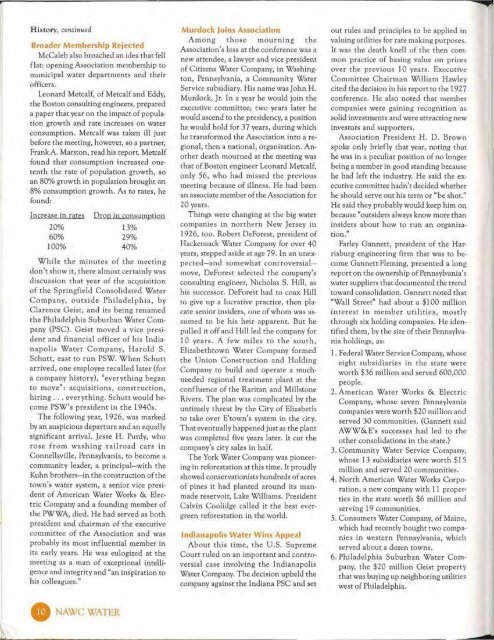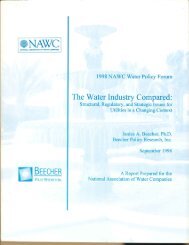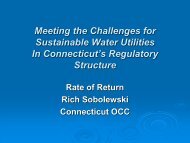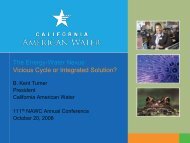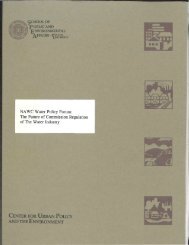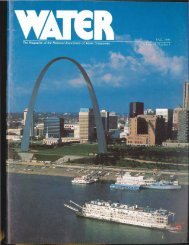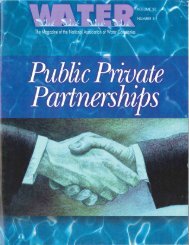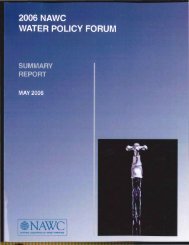Vol 36, No. 1 - NAWC
Vol 36, No. 1 - NAWC
Vol 36, No. 1 - NAWC
Create successful ePaper yourself
Turn your PDF publications into a flip-book with our unique Google optimized e-Paper software.
I<br />
History, continued<br />
Broader Membership Rejected<br />
McCaleb also broached an idea that fell<br />
flat: opening Association membership to<br />
municipal water departments and rheir<br />
officers.<br />
Leonard Metcalf, of Metcalf and Eddy,<br />
the Boston consulting engineers, prepared<br />
a paper that year on the impact of population<br />
growth and rate increases on water<br />
consumption. Metcalf was taken ill just<br />
before the meeting, however, so a partner,<br />
Frank A. Marston, read his report. Metcalf<br />
found that consumption increased one·<br />
tenth the rate of population growth, so<br />
an 80% growth in population brought an<br />
8% consumption growth. As to rates, he<br />
found,<br />
Increase in rru~~<br />
20%<br />
60%<br />
100%<br />
Drop in consumption<br />
13%<br />
29%<br />
40%<br />
While the minutes of the meeting<br />
don't show it, there almost certainly was<br />
discussion that year of the acquisition<br />
of the Springfield Consolidated Water<br />
Company, outside Philadelphia, by<br />
Clarence Geist, and its being renamed<br />
the Philadelphia Suburban Water Company<br />
(PSC)_ Geist moved a vice president<br />
and financial officer of his Indianapolis<br />
Water Company, Harold S.<br />
Schutt, east to run PSW. When Schutt<br />
arrived, one employee recalled later (for<br />
a company history), "everything began<br />
to move": acquisitions, construction,<br />
hiring ... everything. Schutt would be·<br />
come PSW's president in the 1940s.<br />
The following year, 1926, was marked<br />
by an auspicious departure and an equally<br />
significant arrival. Jesse H. Purdy, who<br />
rose from washing railroad cars in<br />
Connellsville, Pennsylvania, to become a<br />
community leader, a principal-with the<br />
Kuhn brothers-in the construction of the<br />
town's water system, a senior vice president<br />
of American Water Works & Electric<br />
Company and a founding member of<br />
the PWWA, died_ He had served as both<br />
president and chairman of the executive<br />
committee of the Association and was<br />
probably its most influential member in<br />
its early years. He was eulogized at the<br />
meeting as a man of exceptional intelligence<br />
and integrity and "an inspiration to<br />
his colleagues."<br />
G <strong>NAWC</strong>WATER<br />
Murdock Joins Association<br />
Among those mourning the<br />
Association's loss at the conference was a<br />
new attendee, a lawyer and vice president<br />
of C itizens Water Company, in Washington,<br />
Pennsylvania, a Community Water<br />
Service subsidiary. His name was John H.<br />
Murdock, Jr. In a year he would join the<br />
executive committeej two years later he<br />
would ascend to the presidency, a position<br />
he would hold for 37 years, during which<br />
he transformed the Association into a regional,<br />
then a national, organization. Another<br />
death mourned at the meeting was<br />
that of Boston engineer Leonard Metcalf,<br />
only 56, who had missed the previous<br />
meeti ng because of illness. He had been<br />
an associate member of the Association for<br />
20 years.<br />
Things were changing at the big water<br />
companies in northern New Jersey in<br />
1926, too. Robert DeForest, president of<br />
Hackensack Water Company for over 40<br />
years, stepped aside at age 79. In an unexpected-and<br />
somewhat controversialmove,<br />
DeForest selected the company's<br />
consulting engineer, Nicholas S. Hill, as<br />
his successor. DeForest had to coax Hill<br />
to give up a lucrative practice, then placate<br />
senior insiders, one of whom was assumed<br />
to be his heir apparent. But he<br />
pulled it off and Hill led the company for<br />
10 years. A few miles to the south ,<br />
Elizabethtown Water Company formed<br />
the Union Construction and Holding<br />
Company to build and operate a muchneeded<br />
regional t reatment plant at the<br />
confluence of the Raritan and Millstone<br />
Rivers. T he plan was complicated by the<br />
untimely threat by the City of Elizabeth<br />
to take over E'town's system in the city.<br />
That eventually happened just as the plant<br />
was completed five years later. It cut the<br />
company's city sales in half.<br />
The York Water Company was pioneering<br />
in reforestation at this time. It proudly<br />
showed conservationists hundreds of acres<br />
of pines it had planted around its manmade<br />
reservoir, Lake Williams. President<br />
Calvin Coolidge called it the best evergreen<br />
reforestation in the world.<br />
Indianapolis Water Wins Appeal<br />
About this time, the U.S. Supreme<br />
Court ruled on an important and controversial<br />
case involving the Indianapolis<br />
Water Company. The decision upheld the<br />
company against the Indiana PSC and set<br />
out rules and principles to be applied in<br />
valuing utilities for rate making purposes.<br />
It was the death knell of the then common<br />
practice of basing va lue on prices<br />
over the previous 10 years. Executive<br />
Committee Chairman William Hawley<br />
cited the decision in his report to the 1927<br />
conference. He also noted that member<br />
companies were gaining recognition as<br />
solid investments and were attracting new<br />
investors and supporters.<br />
Association President H. D. Brown<br />
spoke only briefly that year, noting that<br />
he was in a peculiar position of no longer<br />
being a member in good standing because<br />
he had left the industry. He said the executive<br />
committee hadn't decided whether<br />
he should serve out his term or f< be shot."<br />
He said they probably would keep him on<br />
because "outsiders always know more than<br />
insiders about how to run an organizanon.<br />
. "<br />
Farley Gannett, president of the Harrisburg<br />
engineering firm that was to become<br />
Gannett-Fleming, presented a long<br />
report on the ownership of Pennsylvania's<br />
water suppliers that documented the trend<br />
toward consolidation. Gannett noted that<br />
"Wall Street" had about a $100 million<br />
interest in member utilities, mostly<br />
through six holding companies. He identified<br />
them, by the size of their Pennsylvania<br />
holdings, as:<br />
1. Federal Water Service Company, whose<br />
eight subsidiaries in the state were<br />
worth $<strong>36</strong> million and served 600,000<br />
people.<br />
2_ American Water Works & Electric<br />
Company, whose seven Pennsylvania<br />
companies were worth $20 million and<br />
served 30 communities. (Gannett said<br />
AWW&E's successes had led to the<br />
other consolidations in the state.)<br />
3. Community Water Service Company,<br />
whose 13 subsidiaries were worth $15<br />
million and served 20 communities.<br />
4. <strong>No</strong>rth American Water Works Corporation,<br />
a new company with 11 properties<br />
in the state worth $6 million and<br />
serving 19 communities.<br />
5. Consumers Water Company, of Maine,<br />
which had recently bought two companies<br />
in western Pennsylvania, which<br />
served about a dozen towns.<br />
6_ Philadelphia Suburban Water Company,<br />
the $20 million Geist property<br />
that was buying up neighboring utilities<br />
west of Philadelphia_


